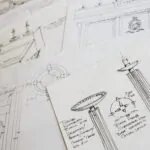As a patent drawing service provider with years of experience in the field, we understand the importance of precise and accurate utility patent drawings. These drawings play a crucial role in the patent application process, as they provide visual representations of the invention’s features and functionalities. However, creating utility patent drawings can be challenging, especially when trying to meet the stringent requirements set by the United States Patent and Trademark Office (USPTO).
In this blog post, we’ll discuss some common mistakes to avoid when creating utility patent drawings. By steering clear of these errors, you can increase the likelihood of your patent application being approved.
1. Neglecting USPTO Requirements
One of the most critical mistakes to avoid is neglecting the specific requirements outlined by the USPTO for utility patent drawings. These requirements cover various aspects such as size, margins, font styles, and line thickness. Failure to adhere to these guidelines can result in rejection or delay of your patent application.
To ensure compliance with USPTO requirements, it’s essential to thoroughly review their guidelines or seek assistance from professionals experienced in patent drawing services. For a comprehensive guide on meeting USPTO requirements, you can refer to The Patent Drawing’s guide.
2. Confusing Utility and Design Drawings
Another common mistake is confusing utility and design drawings. While utility drawings focus on illustrating the functional aspects of an invention, design drawings primarily depict its ornamental features. Mixing up these two types of drawings can lead to confusion and may result in the rejection of your patent application.
It’s crucial to understand the distinction between utility and design drawings and ensure that your utility patent drawings accurately represent the invention’s functional aspects. For further clarification on utility versus design drawings, you can read more here.
3. Lack of Clarity and Detail
Utility patent drawings should be clear, detailed, and easy to understand. Failing to provide sufficient clarity and detail can hinder the examiner’s ability to comprehend the invention fully, leading to potential objections or rejections.
When creating utility patent drawings, strive for clarity by using precise lines, shading, and annotations where necessary. Pay attention to proportions and scale to accurately represent the invention’s dimensions. Additionally, include multiple views or perspectives if needed to provide a comprehensive understanding of the invention’s structure and functionality.
4. Inconsistent or Incorrect Numbering
Proper numbering is essential for utility patent drawings, as it helps identify different components and elements of the invention. Inconsistent or incorrect numbering can cause confusion and make it challenging for examiners to follow the description of the invention.
Ensure that all parts, features, and elements in the drawings are appropriately numbered and labeled according to the accompanying description. Consistency in numbering across different views or figures is also crucial for clarity and comprehension.
5. Ignoring Essential Guidelines
Finally, it’s essential to familiarize yourself with and adhere to essential guidelines for creating utility patent drawings. These guidelines cover various aspects such as drawing format, line quality, symbols, and conventions. Ignoring these guidelines can result in discrepancies or inconsistencies that may raise objections during the examination process.
For a comprehensive understanding of essential guidelines for creating utility patent drawings, refer to resources such as The Patent Drawing’s guide.
In conclusion, avoiding common mistakes in utility patent drawings is crucial for the success of your patent application. By adhering to USPTO requirements, distinguishing between utility and design drawings, ensuring clarity and detail, maintaining proper numbering, and following essential guidelines, you can enhance the quality and accuracy of your utility patent drawings. Remember, for professional assistance in creating utility patent drawings, you can always rely on our experienced team at Patent Drawing Services.








